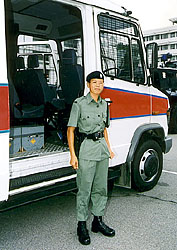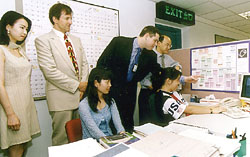



















| |
|
"WITH its power-brakes and power-steering, the
Trooper makes me feel I am driving a private car instead of a police vehicle," said WPC Yuen
Suk-ha, a petite lady who has the distinction of being the Force's first woman driver of these large,
high-performance trucks designed to transport up to 19 officers to trouble spots in safety and comfort.
Since passing out from the Police Tactical Unit last month, she has been driving one of the 43 new Troopers which were delivered to the Force earlier this year. "The vehicle may seem imposing, but its modified Mercedes Benz 4.25 litre turbo-charged diesel engine makes driving it a pleasure," said Ms Yuen. The 29-year-old woman police constable joined the Force in October 1988 after serving in the Correctional Services Department for a year. She drove police vehicles in Wong Tai Sin District for three years before her attachment to PTU. |
 The Trooper has found its match in the diminutive WPC Yuen |
|
According to Ms Yuen, the PTU places the same demands on men and women trainees in all areas including physical fitness. In addition to mastering the Trooper, during her 12-week training period she learned about internal security, anti-crime tactics, crowd management and field patrol. "I've gotten a lot out of the training course and I feel more confident now when faced with emergencies," she said. Equipped with a full range of police lights, siren, fog lamp and a ladder to the roof which can be used as an observation platform, the $600,000 Trooper is made of bandit-proof body work, with a three-door design allowing police officers to get in or out quickly. The vehicle is air-conditioned and each seat has its own headrest and three-point seat belt. According to Senior Inspector MTO/PTU Chan Chung-yu, the Force has ordered more than 200 Troopers which will arrive in Hong Kong in phases for modifications and eventually will replace all existing lorries in the internal security fleet by 2001. | |
| |
 All systems ready to roll. Members of the Duty Scheduler (DS) team checking the latest prototype |
SINCE mid-1997 ISW and ITB staff have been
developing the Duty Scheduler (DS) System, which will be implemented in all land districts and
divisions (including Marine Region's Cheung Chau Division) during August, and will be installed
onto existing FICS and PICS terminals.
SP Mark Medwecki, SP CIS ISW, who has been overseeing development of the system was concerned that the Force had been given too many new systems too quickly in recent months, so to ensure that this system would be simple to use and effective from the very beginning its scope has been kept very simple. |
|
Said Superintendent Medwecki: "The system's primary purpose is to automate production of weekly and daily duty lists; to allow transfer of the daily duty list directly to ECACCS; and to keep duty information "on-line" and thus replace the Pol. 329 (DUTY RECORD). "The system will also provide an "Officer Diary" function which will allow details of future commitments (for example, leave, training courses, etc, to be entered for the year ahead), a function giving daily and monthly deployment summaries, and a function allowing unit commanders to keep track of overtime in their units. Above all, the system will be easy to use." Since March 1998, a prototype has been has been developed "on site" in Central Police Station. This approach was different to that followed in FICS and RICS where prototypes were evaluated by user groups made up of officers who were far removed from the actual working environment. As a result, officers using DS have had hands-on experience and have been able to give user oriented feedback which has helped shape the final system. The system is currently undergoing final testing in Central District and response has been positive. WPC Chu Man-ping of PSU4 CDIV says she "finds the screens very colourful, pleasant to look at and she saves time when compiling the Daily Duty List and sending it to ECACCS, as she can do it straight from her office and no longer needs to go to the report room". CSP Mike Francis, DC CDIST and Chairman of the DS User Group says: "A number of requirements were originally specified, both short and long term, with the basic needs of the user being met by the functions provided in this initial phase of Duty Scheduler. While making the job of officers concerned with the planning of duty lists much more efficient, the system also provides some basic Management Information on deployment and resource breakdowns. The reaction of District staff using the system has been very favourable and we are grateful for the way in which the development staff have been so receptive to our feedback and helpful with the project." SIP Neil Taylor of CIS Division who has been involved with DS from the start adds: "As the DS system uses Microsoft EXCEL it is very user-friendly and easy to learn. Much thought has gone into studying the workflow of compiling duty records, the information required from the system and the various screen lay-outs to be used. We were also determined to provide a visually attractive system with no more boring grey screens to look at." SIP Taylor will be in charge of the DS Implementation Team which will visit every District this August. The system will be rolled out on a District-by-District basis and the Implementation teams will be in the respective Regions during the following dates: HKI Region and CCDIV (27 - 30 July); KE Region (31 July - 5 August); KW Region (6 - 11 August); NTS Region (12 - 19 August); NTN Region (20 - 25 August). During implementation, a presentation will be given to all IP's and above (and civilian equivalents) in each District. In addition, two training sessions will be held for all JPO's and civilians involved with compiling Duty Lists and maintaining the Pol.329. An officer from the team will also provide on-site assistance over three days. Thereafter technical support will be available via the helpdesk while user support will be provided by CIS Division. A self-running tutorial (part of the DS package), available on all terminals, will demonstrate the use of all system functions and features. An user manual will also be issued to all formations. During development of DS, the opportunity to revise FPM 20-04 was taken. Some new duty codes have been added and based on these, the system will provide a better picture of operational deployment in Divisions. For example, Crowd Management (CM) or Public Order (PO) can be selected as a duty code instead of Special Duty (SD) which is currently used as a blanket code to describe many duty types. To minimise disruption, it has been agreed with Support Wing, that the changeover to the new duty codes will be done gradually when Formations start using DS and therefore, formations which have not yet received DS should continue with the "old" duty codes. The formal amendment to the FPM will be issued in March 1999. Once implementation in all land based districts and divisions is complete, the intention is to make the system available to remaining units in the Force. Some additional development effort will be required to adapt the system for use by certain Regional units such as EU and PTU, but most units, particularly PHQ units, should be able to use the system without further modification. The intention is to deliver the system to PHQ units by the end of 1998 and to remaining Regional units by March 1999 which will tie in with the formal adoption of amendments to FPM 20-04. | |


![]()
